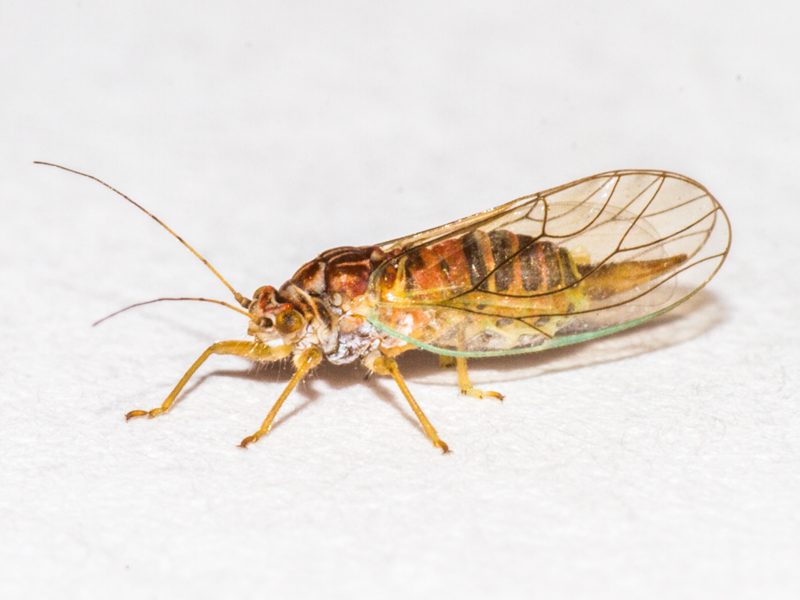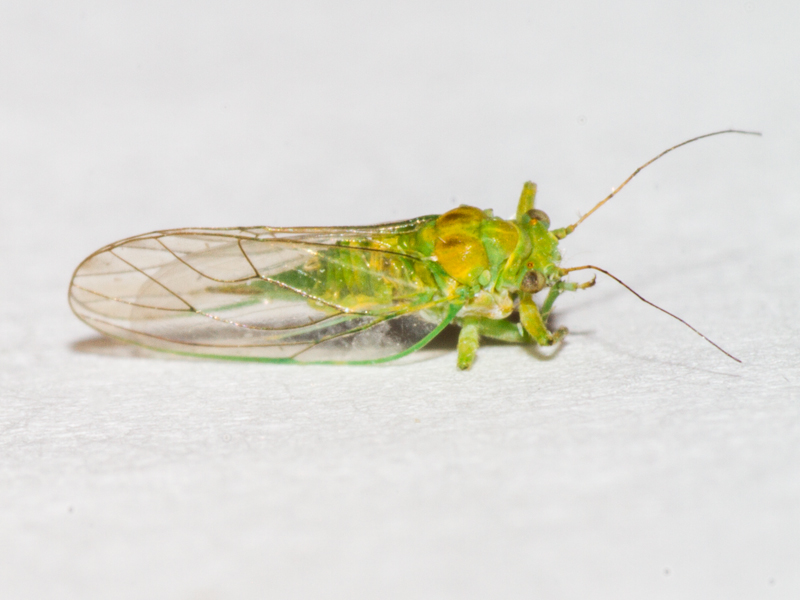Psylla alni
One of our largest (if not the largest?) Psyllids.
Females have quite elongated terminalia.
, North Elmham, 11-Jul-22 (A) (1).jpg)
, North Elmham, 11-Jul-22 (A) (3).jpg)
female Psylla alni showing terminalia, North Elmham (Norfolk, UK), 11th July 2022
Most cells have fairly obvious surface spinules covering the centres of the cells, but clear at the edges alongside the veins (only a very small patch on cell C+Sc). This individual had more of a yellowy wash across the wings than other specimens examined at the same time.
, North Elmham, 16-Jun-22 (A) (1).jpg)
, North Elmham, 16-Jun-22 (A) (2).jpg)
female Psylla alni showing close-up of central part of forewing, North Elmham (Norfolk, UK), 16th June 2022
, North Elmham, 27-Jun-21.jpg)
female Psylla alni, North Elmham (Norfolk, UK), 27th June 2021
Males have blob-ended parameres. You can't see this from the outside, but the inside of the tip has a pair of darkened denticles pointing inwards.
, North Elmham, 11-Jul-22 (B) (1).jpg)
, North Elmham, 11-Jul-22 (B) (3).jpg)
, North Elmham, 11-Jul-22 (B) (4).jpg)
, North Elmham, 11-Jul-22 (B) (5).jpg)
male Psylla alni showing forewing, genitalia (with one paramere removed and turned), North Elmham (Norfolk, UK), 11th July 2022
You don't need to remove the wings to see the shape of the parameres.
, North Elmham, 17-Jul-22 (A) (1).jpg)
, North Elmham, 17-Jul-22 (A) (2).jpg)
, North Elmham, 17-Jul-22 (A) (3).jpg)
male Psylla alni showing genitalia through wings, North Elmham (Norfolk, UK), 17th July 2022
, North Elmham, 23-Jun-19.jpg)
male Psylla alni, North Elmham (Norfolk, UK), 23rd June 2019
One of the reasons I'm building this website is to help me remember what I learn. Coming across this photo of a brown psyllid which I apparently identified confidently as Psylla alni despite that normally being a green insect, and having no recollection of the identification process despite it being less than 18 months ago, is an example of why I wish I started it earlier. I was already familiar with alni, so I think we can assume it was large, and I remember (and did record at the time) that it was taken off alder. Other than the generally brown colour it does seem to fit alni in every respect that you can see in the photo, and it doesn't look right for the other large alder-associated psyllid Baeopelma foersteri. But can alni really be this brown? Well, I have managed to find other photos of brown alni, so I think it's ok. There's one on NatureSpot, though that individual doesn't really look like mine and doesn't look like a healthy insect. Then I came across this one which is a dead-ringer for mine. There's always a chance photos found online are incorrectly identified but looking through other photos here there is an extensive collection of species that seem to be correctly labelled, and one or two that are left unidentified where there is doubt about the specific ID, so it seems to be a reliable source. So unless anyone contacts me to caution otherwise, I'm concluding that my original ID was correct and that alni can indeed have a brown appearance. For what it's worth, I found 10 Psylla alni at the same site the following year.

female Psylla alni, Wendling Beck Environment Project (Norfolk, UK), 24th September 2021
 (1).jpg)
 (2).jpg)
 (3).jpg)
male Psylla alni, North Elmham (Norfolk, UK), 27th July 2018

female Psylla alni, North Elmham (Norfolk, UK), 31st July 2020
